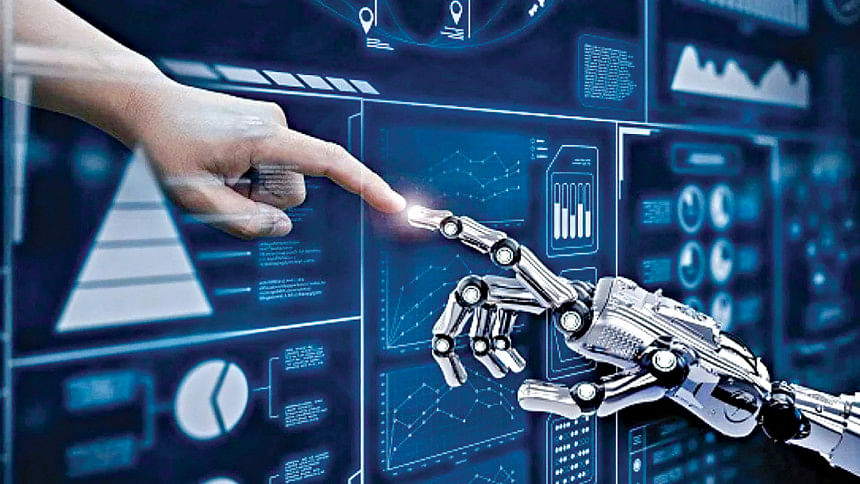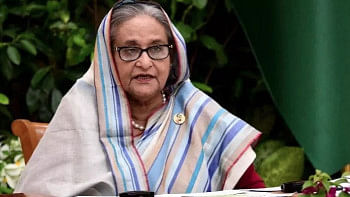Staying on top of the 4IR at the policy level

Bangladesh is poised to join the ranks of middle-income countries in 2026, and industrial growth will form the backbone of our economy as we make this transition. However, rapid industrial growth faces several challenges and simultaneously provides an opportunity to learn from the mistakes made by the developed countries during the Third Industrial Revolution. One of the unintended consequences of the rapid economic growth in the last 150 years has been industrial pollution, climate change, and depletion of natural resources.
Currently, there are two major issues that Bangladesh seeks to address:
1) What options do we have in terms of choice of technology to build our industrial sector?
2) How do we move forward in the Fourth Industrial Revolution (4IR) and maintain the dynamism without contributing to climate change?
Sustainable technology and industrial growth movement have arisen out of the awareness that industrial expansion has occurred at some cost to public health and the environment. We are now identifying a pathway to cleaner production including clean technology, processes, and products. Cleaner production is a comprehensive, preventative strategy for environmental protection that encompasses the conservation of energy and materials, eliminating toxic substances, and reduction of wastes and pollutants created by processes and products. This approach relates to all phases of manufacturing processes and product life cycles, including product use. Sustainable technology is a general concept that focuses on developing, demonstrating, and evaluating innovative processes for reducing pollution through source reduction. The life cycle of a product needs to be analysed to focus on the design and development of products whose manufacture, use, recycling, and disposal reduce environmental impacts.
Can the Bangladesh government and the industrial sector recognise the opportunities that lie ahead as we strive to achieve the targets of SDG9? Our industries are already shifting away from treating or disposing industrial waste to preventing its creation. In the garments industry, the owners have embraced eco-friendly practices and begun to appreciate that a comprehensive environmental management plan can benefit the environment. It is also good for the bottom line since it leads to savings in energy, water, and raw materials.
Many innovative concepts that have gained coinage in US industries can provide important pointers for Bangladeshi leaders, in private as well as in public sectors. Some of these are listed below.
Industrial ecology (IE)
This concept is closely related to clean technology and sustainability. IE refers to a new strategy for the industrial design of products and processes that lead to the implementation of sustainable manufacturing. In this approach, not only are environmental considerations incorporated into all aspects of product and process design, but technology also plays a more active and positive role in achieving sustainable development. According to professor Thomas Graedel, Clifton R Musser Professor Emeritus of Industrial Ecology at Yale, IE "seeks to optimise the total materials cycle from raw materials to finished materials, to product, to waste product, and to ultimate disposal (Graedel, TE et al., Proceedings of the National Academy of Sciences)."
Design for environment (DfE)
Based on the principles of IE, the concept of design for environment (DfE) is a means to achieving environmentally conscious designs. The EPA considers the DfE as an "innovative, non-regulatory initiative to help companies consider human health, environmental and economic effects of chemicals and technologies, as well as product performance, when designing and manufacturing commercial products and processes."
Green design/green products
Clean or green products require green design because product design determines input materials, manufacturing processes, packaging, distribution, and disposal methods. Product design decisions significantly affect the quantity of wastes generated at different stages of a product's life cycle. To promote green design, professor VN Bhat suggests two broad green design strategies: source reduction and waste management.
Source reduction includes, but is not limited to, reducing the use of non-recyclable materials, replacing disposable materials and products with reusable materials and products, reducing packaging, reducing the amount of yard wastes generated, establishing garbage rate structures with incentives to reduce the amount of wastes that generators produce, and increasing the efficiency of the use of paper, cardboard, glass, metal, plastic, and other materials.
Interestingly, a source reduction strategy may include designing packaging for products to minimise waste generated after consumer use. The literature is replete with designs and practices that minimise waste, and as we know, the issue of waste management has already become one of the priorities for our government and private entities.
Life cycle analysis (LCA)
Life cycle analysis (LCA) is an analytic methodology developed for evaluating the costs and benefits of various green designs for cleaner production. The objective of LCA is to estimate the total environmental risk from input and output wastes generated during extraction, manufacturing, product distribution, product use, and disposal. LCA is known by other names, including product life cycle analysis, eco-balance, cradle-to-grace analysis, and resource and environmental profile analysis.
Sustainable manufacturing
Sustainable manufacturing is another term in the literature for cleaner production/clean technology. Some define sustainable manufacturing as "a comprehensive business strategy that aims to incorporate environmentally proactive thinking into every step of the manufacturing process." Sustainable manufacturing is, however, a larger concept that includes pollution prevention, DfE, toxic use reduction (TUR), and product LCA. The National Wildlife Federation Corporate Conservation Council (NWFCCC) clearly differentiates among these concepts. According to them, DfE revolves only around the product and does not include work environment, factory and machinery design, or overall corporate environmental policy. TUR focuses on internal and external chemical risks at the process and worker levels but does not take into account packaging, energy use, or end product disposal. Product LCA defines the environmental life of the product but does not address management strategies or worker health and safety issues. Sustainable manufacturing, in contrast, includes:
• Materials selection
• Design for environment
• Optimising production using pollution prevention and TUR strategies
• Energy conservation
• Eliminating worker health and safety risks
• Reducing packaging and using reusable packaging
• Design for disassembly, that is, design of products for repair and replacement of components rather than disposal
• Design for recycling and reuse, that is, reducing product persistence in the environment.
Next steps for Bangladesh
I present some of the policy initiatives essential for Bangladesh to promote sustainable industrial growth with clean technology. Some of these prescriptions are for the government, while the others are for different stakeholders.
Regulatory initiatives
• Source reduction (input substitution; product reformulation; process redesign)
• Multimedia focus, including worker health
• Coordination of environmental, energy, and industrial policies
• Design regulation to get the technology desired
• Strict standards with flexible provisions
Technical assistance initiatives
• Technical assistance to firms
Economic instrument initiatives
• Tax policy
• Taxes on inputs and production
• Liability and financial responsibility
Stakeholder participation initiatives
• Involve citizens and workers
International policy initiatives
• Devise international policies
Fortunately, for emerging economies such as Bangladesh, we can take advantage of multiple sources and global initiatives. We can also participate more actively in the Technology Bank (TB) initiative of the multilateral agencies. The TB partnership brings together United Nations agencies, 180 international publishers, universities, and other organisations to provide researchers in the developing world with online access to international academic and professional journals, databases, and other information resources. Fortunately, TB is currently focusing on improving access for scientists and researchers to data, publications and science, technology and innovation (STI) initiatives in 12 LDCs: Bangladesh, Bhutan, Burkina Faso, Liberia, Madagascar, Malawi, Mozambique, Nepal, Rwanda, Senegal, Tanzania, and Uganda.
For the private sector, there are important lessons for the next decade. While executives are complaining about the cost of hiring when labour market is tight and business needs change, they need to look inwards and retrain their own workers and ask the HR to create programmes to reskill their existing manpower. A big challenge for the government, industrial owners, and entrepreneurs is the investment needed for skills development, workforce development, and training.
If Bangladesh is to seek a niche in the biotech industry, it must adhere to "good manufacturing practices (GMP)," with a plan for cleanrooms, and tout a modular configuration that will enable the easy adoption of emerging technologies manufacturers. Globally, demand for these biological products, such as cell and viral vector products, is so high that the resulting manufacturing bottlenecks can ultimately limit the number of patients who are able to access medical breakthroughs produced using cell and viral vectors. Obviously, there is a role for a regional leader to manage quality control, lab, office, and convening space designed to facilitate collaboration between scientists from the region's universities, hospitals, and industries. Bangladesh must prepare itself for this position.

 For all latest news, follow The Daily Star's Google News channel.
For all latest news, follow The Daily Star's Google News channel. 



Comments